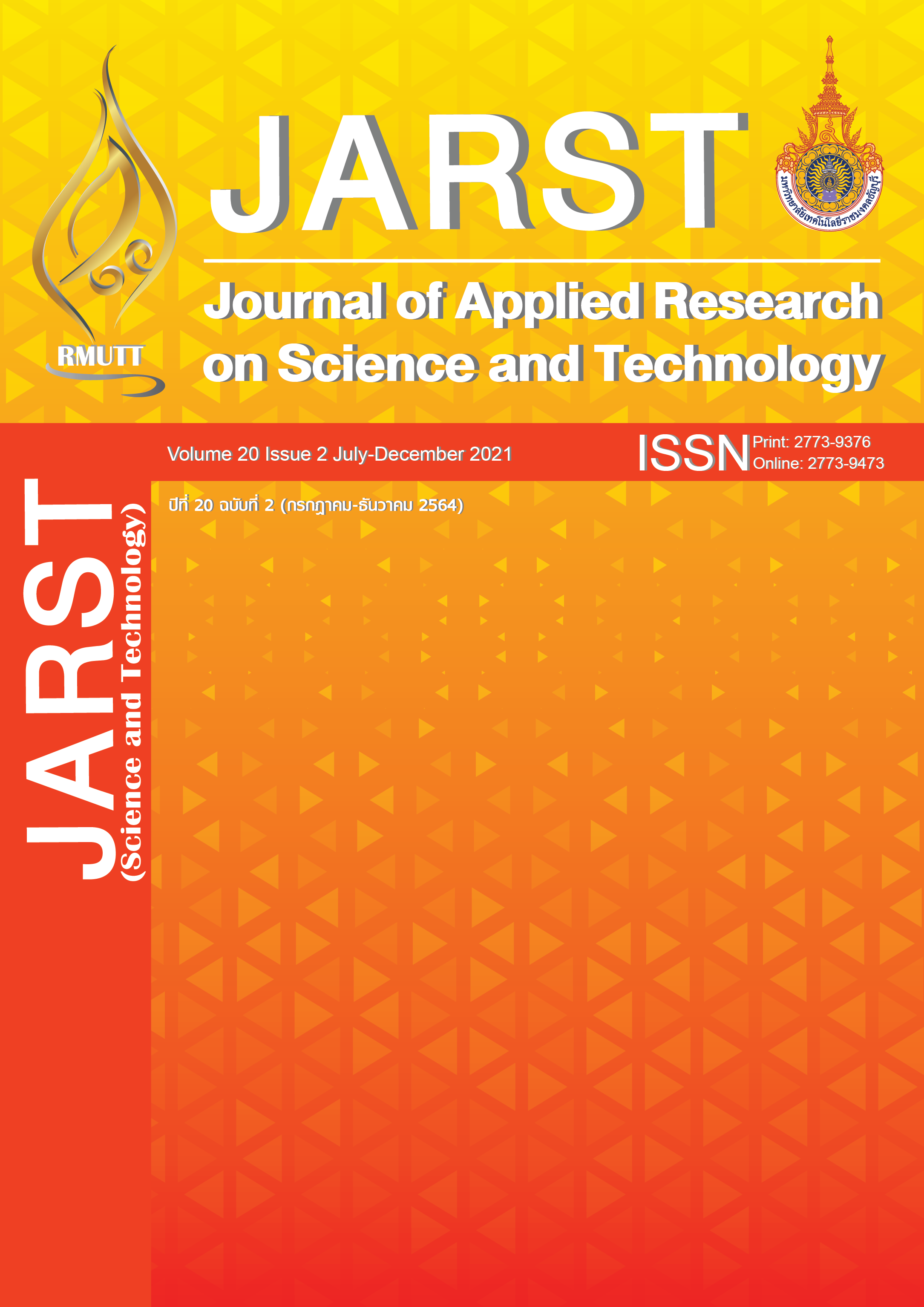Antioxidant Activity of Chitooligosaccharides Produced by Chitinase Extracted from two Weeks Seedlings of Samanca saman (Jacq) Merr.
Main Article Content
Abstract
This research was to study the antioxidant activity of chitooligosaccharides from two weeks seedlings of Samanca saman (Jacq) Merr. produced by chitinase with extraction of 0.1 molar acetate buffer at pH 3.5 was investigated in this work. It was found that chitooligosaccharides obtained from hydrolysis of 1 percent of colloidal chitin in 0.1 molar acetate buffer pH 3.5 using chitinase extracted from two weeks seedlings of Samanca saman (Jacq) Merr. at 0.5 hour digestion, chitooligosaccharides were produced from hydrolysis of 1 percent of colloidal chitin in 0.1 molar acetate buffer pH 3.5 utilizing chitinase isolated from two weeks seedlings of Samanca saman (Jacq) Merr. It comprises acetylglucosamine as well as (GlcNAc)2, (GlcNAc)3, (GlcNAc)4, (GlcNAc)5, and (GlcNAc)6 of chitooligosaccharides. The small molecules of (GlcNAc)1, (GlcNAc)2 and (GlcNAc)3 increased with 1 hour, 2 hours and 4 hours of curing time, the small molecules of (GlcNAc)1, (GlcNAc)2, and (GlcNAc)3 increased, whereas the large molecules of (GlcNAc)4, (GlcNAc)5 and (GlcNAc)6 decreased. The large molecules of (GlcNAc)4 changed to (GlcNAc)2 + (GlcNAc)2 and (GlcNAc)1 + (GlcNAc)3, (GlcNAc)5 changed to (GlcNAc)2 + (GlcNAc)3 and (GlcNAc)1 + (GlcNAc)4, (GlcNAc)6 changed to (GlcNAc)3 + (GlcNAc)3, (GlcNAc)2 + (GlcNAc)4 and (GlcNAc)1 and (GlcNAc)5. Chitooligosaccharides obtained from the use of every curing time to digest which have antioxidant activity better than butylated hydroxyl toluene (BHT) standard. The EC50 of 0.5 hour, 1 hour, 2 hours and 4 hours incubation were 1.01 0.1, 1.07 0.1, 1.12 0.1 and 1.18 0.1 µg/mL, respectively, which less than the EC50 of BHT standard of 1.34 0.1 µg/mL. The large molecules of chitooligosaccharides from shorter curing time (0.5 hour) have more antioxidant activity than small molecules from longer curing time (1 hour, 2 hours and 4 hours).
Article Details

This work is licensed under a Creative Commons Attribution-NonCommercial-NoDerivatives 4.0 International License.
References
Chernin LS, Fuente LD, Sobolev LV, Haran S, Vorgias CE, Oppenheim AB, et al. Molecular cloning, structural analysis, and expression in Escherichia coli of a chitinase gene from Enterobacter Agglomerans. Appl Environ Microb. 1997;63(3):834–9.
Malik A. Purification and properties of plant chitinases: A review. J Food Biochem. 2019;43(3):1-11.
Baureithel K, Felix G, Boller T. Specific, high affinity binding of chitin fragments tomato cells and membranes, competitive inhibition of binding by derivatives of chitooligosaccharides and a nod factor of Rhizobium. J Biol Chem. 1994;269(27):17931-8.
Shibuya N, Kaku H, Kuchitsu K, Maliarik MJ. Identification of a novel high-affinity binding site for N-acetylchitooligosaccharide elicitor in the plasma membrane fraction from suspension-cultured rice cells. FEBS. 1993;329:75–8.
Coelho JF, Ferreira PC, Alves P, Cordeiro R, Fonseca AC, Gois JR, et al. Drug delivery system: advanced technologies potentially applicable in personalized treatments. EPMA Journal. 2010;1(1):164-209.
Kaomek M. Antioxidant activity by chitooligosaccharides of chitosanase from Samanca saman (Jacq) Merr, Leucaena leucocephla de Wit, Oryza sativa RD. 6 and Sorghum vulgare KU 630. VRU Research and Development Journal Science and Technology. 2019;14(3):62-71.
Phumkhonsan P, Kaomek M. Assessment of charats and activities of chitinase from Samanca saman (JACQ). Sri-ayutthaya cluster 9th Rajabhat university national conference; 18 Oct 8; Valaya Alongkorn Rajabhat University; 2018.
Kaomek M. Antifungal acitivity of chitoloigosaccharides from Samanca saman (JACQ) Merr., Leucaena leucocephala de wit, Oryza sativa RD. 6 and Sorghum vulgare KU 630 produced by chitinase. VRU Research and Development Journal Science and Technology. 2020;15(2):119-30.
Moon C, Seo D, Song Y, Hong S, Choi S, Jung W. Antifugal activity and patterns of N-acetyl-chitooligosaccharide degradation via chitinase produced from Serratia marcescens PRNK-1. Microb Pathogenesis. 2017;113:218-24.
Boller T, Gehri A, Mauch F, Vogeli U. Chitinase in bean leaves: induction by ethylene, purification, properties and possible function. Planta. 1983;157:22-31.
Berger LR, Reynold DM. The chitinase system of a strain of griseus. Biochimi Biophys Acta. 1958;29(3):522–34.
Lowry OH, Rosebrougly NJ, Farr AL, Randall RJ. Protein measurement with the folin phenol reagent. J Biol Chem. 1951;193:256-7.
Miller GC. Use of Dinitrosalicylic Acid Reagent for Etermination of Reducing Sugar. Analytical Chemistry. 1959;31:426-8.
Pownibg RF, Lrzykiewicy H. Separation of Chitin Oligosaccharide by Thin Layer Chromatography. J Chromatogr. 1967;27:115-9.
Koga D, Yoshioka T, Arakane Y. HPLC analysis of anomeric formation and cleavage pattern by chitinolytic enzyme. Biosci Biotech Bioch. 1998;62(8):1643-6.
Brand WW, Cuvelier ME, Berset C. Use of a free radical method to evaluate antioxidant activity. Lebensm Wiss Technol. 1995;28(1):25-30.
Testhong W, Kaomek M. Antioxidant activity of chitooligosaccharides produced by chitinase from Leucaena leucocephala de wit. Journal of Research and Innovation in Science and Technology. 2021;2(2):16-27.
Phomniles B, Kaomek M. Patterns and antioxidant activity of chitooligosaccharides produced by chitinase from Oryza sativa RD.6. The 8th Acdemic Science and Technology Conference 2021; 21 Mar 26; Valaya Alongkorn Rajabhat University; 2021.

